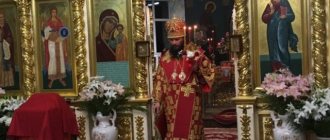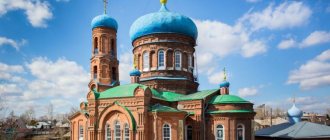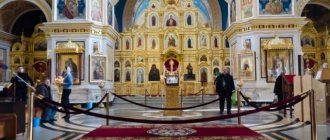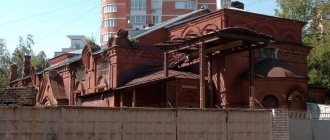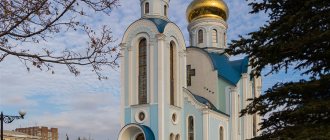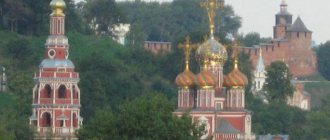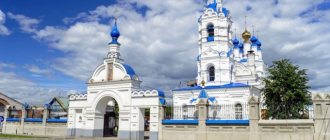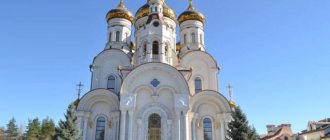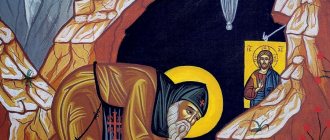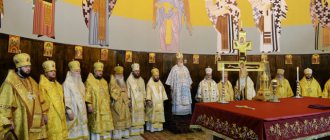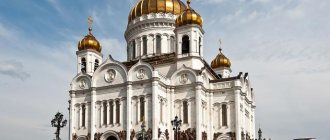There is a certain chronicle that contains information that Metropolitan Leonty of Kiev and All Rus' appointed Bishop Nikita to Belgorod so that he would establish a diocese there.
This diocese was supposed to serve as an educator and disseminator of the Light of Christ's Truth among the local people and the settlements of nomadic tribes nearby Belgorod.
992
this year the Belgorod diocese was founded
One of these dioceses is the Belgorod Diocese, founded back in 992.
However, the diocese was unable to resist the attacks of the pagans. And soon the hordes of Khan Batu wiped out the entire city of Belgorod from the face of the earth. The diocese ceased to exist for a long time, in fact for six long centuries.
Temple of Seraphim of Sarov, belongs to the Belgorod diocese
The formation of the Belgorod diocese occurred in the 17th century
The next stage in the formation of the Belgorod diocese was the 17th century, namely 1657, when, by order of Patriarch Nikon of Moscow and All Rus', the future Patriarch of Moscow and All Rus' Pitirim was appointed to the see of Belgorod.
Patriarch of Moscow and All Rus' Nikon is the Moscow Patriarch, by the grace of God a great lord and sovereign. It was he who was appointed to the department of Belgorod in 1657
Metropolitan Pitirim, at this time, was at the Krutitsa and Kolomna Sees, in the position of Metropolitan of Sarsk and Podonsk - the oldest episcopal title of Moscow Rus'.
However, Metropolitan Pitirim at that time occupied the position of patriarchal vicar, that is, his deputy, and, refusing to accept the appointment, did not go to his new see.
As a result of this, the diocese of a non-ruling bishop cannot exist, so the department was not opened.
A few days after Metropolitan Pitirim’s refusal to go to the Belgorod See, on paper, it was officially annexed to the Krutitsa Metropolis.
This was officially motivated by the fact that once in the old days, the Sarsk and Podonsk diocese was part of the Sarsko-Golden Horde bishopric, which included many other territories, including the entire southern region of the Belgorod region, among which were the cities of Belgorodchina and Slobozhanshchina.
This is how everything remained until the meetings of the Great Moscow Council of 1666-1667, which, in one of its resolutions, determined that the clergy should nourish the distant outskirts of Rus' with the Light of Christ's Truth.
At the end of 1667, the Belgorod diocese was allocated
In this regard, at the end of 1667, the Belgorod diocese was separated from the Patriarchal Region, uniting within its borders the Kharkov, Belgorod, Kursk, parts of the Oryol and Sumy modern regions, which was to be called a metropolis.
The title of the ruling bishop was to be called Metropolitan of Belgorod and Oboyan. The first bishop of the revived diocese was Metropolitan Theodosius of Belgorod and Oboyan, who came from Serbia.
Metropolitan Feodosius of Belgorod and Oboyan - the first bishop of the newly revived diocese
This was the case until the establishment of the Holy Synod in 1721. From that time on, they were called bishops or archbishops, with the exception of one Anthony of Chernavsky, who was ordained to the rank of metropolitan in his homeland.
From 1667 to 1787, the archpastors were called Belograd and Oboyan, from 1787 to 1799 Belgorod and Kursk, and from 1799 - Kursk and Belgorod.
On the day of its opening, the Belgorod department included a total of 37 cities, 20 of which were ancient, including Belgorod itself, and the remaining 17 were newly rebuilt and newly created, including the city of Kharkov.
542 churches
had the Belgorod Metropolis according to documents of 1679
Documents from 1679 say that the Belgorod Metropolis has 542 churches.
No. 28 (637) / July 18 '11
Diocese
Archbishop John of Belgorod and Stary Oskol
Date of birth: September 1, 1960 Date of ordination: April 4, 1993 Date of tonsure: March 30, 1990 Angel Day: June 23.
- Born in Irkutsk into a family of employees. After graduating with honors from secondary school No. 1 in Shelekhov, in September 1977 he entered the history department of Irkutsk State University. A. Zhdanova.
- After graduating from the university, he taught at the institute and entered graduate school at Novosibirsk State University, but in 1983, of his own free will, he left teaching at the institute and was accepted into the church choir of the Znamensky Cathedral in Irkutsk.
- In 1984, he combined the obedience of subdeacon of Archbishop of Irkutsk and Chita Yuvenaly and director of the candle factory of the Irkutsk diocesan administration.
- In 1985, in connection with the transfer of Archbishop Yuvenaly to the Kursk See, he moved to Kursk, where he served as the archbishop’s cell attendant, and then as his personal secretary.
- In September 1985 he entered the Leningrad Theological Seminary, and in 1988 the Leningrad Theological Academy.
- In December 1989, with the blessing of Metropolitan Alexy of Leningrad and Novgorod, the future Patriarch, he was sent to the Kursk diocese, where on March 30, 1990 he was tonsured a monk with the name John, in honor of Metropolitan John of Tobolsk and All Siberia, the miracle worker.
- On April 4, 1990, he was ordained to the rank of deacon, and on April 7, on the day of the Annunciation of the Most Holy Theotokos, he was ordained to the rank of presbyter.
- In June 1990, he was appointed rector of the reviving Kursk Theological School and elevated to the rank of abbot, and in December 1991, in connection with the transformation of the school into a theological seminary, he was appointed rector of the Kursk Theological Seminary.
- In 1993 he was elevated to the rank of archimandrite.
- By the decision of the Holy Synod of February 22-23, 1993, Archimandrite John (Popov), rector of the Kursk Theological Seminary, was appointed Bishop of Belgorod, vicar of the Kursk diocese, while retaining the duties of the rector.
- By the decision of the Holy Synod of April 4, 1993, he was ordained to the rank of bishop with the title of Belgorod.
- By decision of the Council of Bishops in 1994, he was appointed chairman of the working group for planning the revival of the Orthodox mission in the canonical territory of the Russian Orthodox Church.
- On July 18, 1995, by determination of the Holy Synod in connection with the formation of the Belgorod-Stary Oskol diocese, he was appointed Bishop of Belgorod and Stary Oskol.
- In December 1995, he created the Missionary Orthodox Charitable Foundation of the Russian Orthodox Church, which included RAO Gazprom, Kremlevsky Bank and others as founders.
- By decision of the Holy Synod of December 26, 1995, he was appointed chairman of the newly formed Missionary Department of the Russian Orthodox Church.
- By decision of the Holy Synod of December 26, 1995, he was relieved of the post of rector. By the decision of the Holy Synod of July 17, 1996, the Belgorod Orthodox Theological Seminary (with a missionary orientation) was formed. His Eminence John, Bishop of Belgorod and Stary Oskol, was appointed rector of the newly formed seminary.
- On February 18, 1999, for his many labors in establishing the Mother Church, he was elevated to the rank of archbishop.
- Archbishop John of Belgorod and Stary Oskol is a full academic member of the Petrine Academy of Sciences, the International Cyril and Methodius Academy of Slavic Education, and an honorary professor of Belgorod State University.
- Since December 2004, he has headed the Commission on Spiritual Security under the Plenipotentiary Representative of the President of the Russian Federation for the Central Federal District.
- Since March 22, 2011, member of the Supreme Church Council of the Russian Orthodox Church.
Education:
- 1982 – Irkutsk State University;
- 1988 – Leningrad Theological Seminary;
- 1992 – Leningrad Theological Academy.
Awards
- church: – 2010 – Order of St. Seraphim of Sarov, II degree; – 2008 – Order of St. Blgv. Prince Daniil of Moscow, II degree; - Order of St. Sergius of Radonezh II degree; - Order of St. Innocent, Met. Moscow.
- secular: – State Order of Friendship; – medal “For services to the land of Belgorod”, 1st degree; – badge of the collegium of editors-in-chief of regional newspapers of Russia “The Fourth Power. For services to the press."
History and modernity
Holy Belogorye
“That same summer, Leontes, Metropolitan of Kiev and All Rus', installed Nikita in Belgorod,” - this is how the chronicle tells about the establishment of the Belgorod diocese in 992, which enlightened our Russian ancestors with the light of Christ’s truth, and with them the nomadic peoples of the steppes living nearby. However, the diocese did not last long - under the blows of the hordes, Batu disappeared after the destruction of Belgorod. Only by order of Tsar Alexei Mikhailovich was the episcopal see restored in Belgorod, and from 1667 Belgorod became the cathedral city of the vast Belgorod diocese, which united within its borders the Kharkov, Belgorod, Kursk, parts of the Oryol and Sumy modern regions. The first bishop of the revived diocese was Metropolitan Theodosius of Belgorod and Oboyan, who came from Serbia. In 1799, the Belgorod diocese was divided into Kharkov and Belgorod. Archbishop of Belgorod, His Eminence Theoktist (Mochulsky), established the Theological Seminary, which from 1791 to 1805 trained more than 1,000 graduates for service in the Church, army, medicine and government. Since 1833, the center of the Belgorod diocese moved to Kursk. Of all the archpastors who served at the Belgorod See during its centuries-old history, Bishop Joasaph of Belgorod and Oboyan was truly noted for national love and unfading glory in the ranks of saints.
The Belgorod land is rightfully called Holy Belogorye: many Orthodox churches, monasteries, chapels, healing springs, miraculous icons and other shrines have long attracted not only pilgrims, but also all famous travelers, scientists, poets and writers who visited Belgorod and the region and left behind this region and its shrines have their own memories. By the end of the 20th century, very little of all this wealth and abundance remained.
Shrines of the diocese
Among the Orthodox Belgorod shrines that have survived to this day or have been acquired recently, the icon of St. Nicholas the Ratnoy, which, according to legend, appeared in the 13th century at a spring in the village of Ustinka and saved the inhabitants from a Tatar raid, is noted for national veneration and worship. According to other sources, the word “military” in the name of the icon appeared under Tsar Ivan Vasilyevich (Grozny) during the battle with the Tatars near Kazan, then it was moved to the Korenskaya Nikolaev Monastery, where it remained until 1765, when, after the abolition of the monastery, it was moved to Belgorod and placed in the Holy Trinity Cathedral. In 1923, after the cathedral was closed by the Bolsheviks, traces of the icon were lost. It was found only in 1993. The image was badly damaged, the board was burned, only the face of St. was visible. Nicholas. After restoration in the icon-painting workshop of the Holy Trinity Sergius Lavra, the restored icon was placed in the Transfiguration Cathedral in Belgorod.
On the night of October 15 (2nd Art. Art.), 1703, the icon of the Most Holy Theotokos “Smolensk” (Hodegetria) miraculously shone above the gates of the Belgorod fortress wall. She was transferred to the temple, but was soon found again in the same place. In 1705, a wooden church was built there, and in 1743 the stone Smolensk Cathedral was consecrated, on the second floor of which in 1763 the Church of the Holy Apostles Peter and Paul was consecrated. During the years of Soviet power, the cathedral was closed and destroyed, the icon disappeared. Through the efforts of clergy and laity, the cathedral was restored and on December 13, 1994, the lower church was consecrated in it, and on July 11, 1996, the upper church of the Holy Apostles Peter and Paul was consecrated.
At the beginning of the 17th century, in a swamp near the village of Koshary, a cross was miraculously found, thrown there on the orders of the wicked landowner Yuri Vyrodov. The cross became famous for numerous healings. At the site where the cross was found, a healing spring appeared (it was filled up during the years of Soviet power and again cleared and consecrated in 1998). In 1863, with donations from wealthy Belgorod residents, the Church of the Exaltation of the Cross was built, in the iconostasis of which a miraculous cross was inserted. There he is currently located.
Among other famous Orthodox shrines of the Belgorod region, it should be noted the icons of the Most Holy Theotokos “Life-Giving Source” (Stary Oskol, 18th century), “Helper in Childbirth” (revealed in the 17th century, now located in the Transfiguration Cathedral, Gubkin) , Kazan (XVIII century, located in the Holy Trinity Church in Stary Oskol), icons of the holy great martyr Paraskeva Friday (XVIII century, now located in the Assumption Church in Novy Oskol), holy great martyr and healer Panteleimon (revealed at a spring in the forest near village of Vyazovoe, Prokhorovsky district at the end of the 18th century; now its miraculous list is in the St. Nicholas Church of the same village). In addition to Saint Joasaph (Gorlenko) (1705-1754), the Belgorod land was consecrated by the feet of the confessors and new martyrs Archbishop Onufry (Gagalyuk), Bishop Nikodim (Kononov) and Bishop Anthony (Pankeev).
The light of Christ to people
On May 3, 1995, His Holiness Patriarch of Moscow and All Rus' Alexy II consecrated the temple in honor of the Holy Apostles Peter and Paul and the Belfry memorial on the third field of glory of Russian weapons - the site of the greatest tank battle of the Great Patriotic War - in the village of Prokhorovka.
On September 29, 1996, His Holiness Patriarch of Moscow and All Rus' Alexy II consecrated the Transfiguration Cathedral, built in the city of Gubkin, the second largest and most beautiful after the Moscow Cathedral of Christ the Savior, as a temple of reconciliation of peoples who bore on their shoulders the tragedy, hardships and sorrows of the Great Patriotic War . And the day before, on September 28, His Holiness the Patriarch solemnly opened the Belgorod Orthodox Theological Seminary with a missionary orientation, the first and so far the only seminary of this profile in Russia.
One of the important areas of the reviving mission of the Orthodox Church is its social service. Clergy, monastics and laity of the diocese, students of the theological seminary provide spiritual care and provide practical assistance to people in hospitals, homes for the elderly and disabled, prisoners serving sentences in places of deprivation of liberty. Through the joint efforts of the regional administration and the diocese, the Territorial Center for Services for the Elderly and Disabled was created and opened on October 10, 1997, consecrated in the name of Blessed Xenia of St. Petersburg in the village of Gorki, Krasnensky district. In accordance with the cooperation agreement concluded between the diocese and the department of social protection of the population, the clergy provide spiritual care for the shelters, nursing homes, boarding schools and orphanages assigned to each parish in the diocese.
Sisterhoods of mercy have been created and operate at the Marfo-Mariinsky Convent and at the Church of the Holy Great Martyr and Healer Panteleimon in the 2nd City Hospital of Belgorod. In the surgical department of the 1st city hospital, a temple in the name of St. Luke (Voino-Yasenetsky) was equipped and consecrated. Divine services there and spiritual care for the sick are performed by the priests of Belgorod churches.
In 1996, a temple in the name of the Holy Great Martyr George the Victorious was equipped and consecrated in a maximum security colony in the village of Sosnovka (within the city of Belgorod), churches and prayer rooms were equipped in institutions of the criminal correctional system located in the cities of Valuyki, Stary Oskol and Novy Oskol.
The revived diocese brings the light of Christ to people serving in the Armed Forces and law enforcement agencies. Cooperation agreements have been concluded with the border control detachment “Belgorod”, the special forces detachment “Sokol”, and with Belgorod customs.
The Orthodox Youth Missionary Center in honor of the Holy Martyrs Grand Duchess Elizabeth and Nun Barbara, created in November 1995 at the St. Michael's Church in Belgorod, is engaged in the spiritual and moral education of youth; the center’s employees give Orthodox programs and talks at universities in the city, hold weekly meetings at the Belgorod Theological Seminary (with a missionary focus), and publish the newspaper “Light of Christ.”
In 1995, the Belgorod Orthodox Gymnasium was opened in honor of the Holy Equal-to-the-Apostles Methodius and Cyril, and in 1998 - the Stary Oskol Orthodox Gymnasium in the name of the Holy Blessed Prince Alexander Nevsky. Summer holidays for children are organized in the children's Orthodox camp "Pchelka" in Shebekino, the teenage camp "Belgorodskaya Cherta", in the Lebedinsky GOK dispensary "Lesnaya Skazka", and other children's holiday camps in the deanery districts of the diocese. The Children's Orthodox Missionary Center in the name of the Blessed Tsarevich Dimitri, created at the Tikhvin Church in Shebekino, is actively operating.
Brief information
Date of creation: July 17, 1995 Address: 308000, Belgorod, Slavy Ave., 31 Telephone: Fax: E-mail:
The diocese was established in 1667 as Belgorod and Oboyansk. The diocese included modern Kursk, Belgorod, Kharkov, Sumy regions, parts of the Oryol and Voronezh regions. Since 1787 - Belgorod and Kursk. In 1799 the diocese was renamed Kursk and Belgorod, but until 1833 diocesan institutions and administration remained in Belgorod. In 1905, the Belgorod Vicariate of the Kursk Diocese was established, which was named Kursk and Oboyansk. In November 1933, the vicariate was transformed into the Belgorod diocese. After the arrest of the Ruling Bishop in 1935, there were no new appointments to the department; Orthodox parishes were again cared for by the Kursk archpastors. In 1993, the Belgorod Vicariate of the Kursk Diocese was restored. On July 17, 1995, the vicariate was transformed into an independent diocese, called Belgorod and Stary Oskol. The diocese unites parishes located in the Belgorod region.
- Transfiguration Cathedral: 308000, Belgorod, st. Preobrazhenskaya, 63-v; tel.: (4722) 32-01-82; Fax; e-mail; website: favor.csn.ru.
- Alexander Nevsky Cathedral: 309518, Stary Oskol, st. Tokareva, 4/1; tel.: (4725) 25-35-52, 25-35-70; e-mail; website: st-sobor.belnet.ru.
Monasteries
- Holy Trinity Kholkovsky male: 309573, Chernyansky district, village. Withers; tel.: (47232) 4-06-23.
- Marfo-Mariinsky Women's University: 308015, Belgorod, st. Pushkina, 19; tel..
- Voskresensky Women's: 309273, Shebekinsky district, village. Zimovenka, st. Sick leave; tel.: (47248) 7-76-70.
Mass media
Diocesan printed publications:
- Belgorod Diocesan Gazette (monthly newspaper)
- "Missionary Review" (monthly magazine)
- "Virtue" (monthly magazine).
Electronic media:
- official website of the Belgorod diocese;
- diocesan video channel on YouTube;
- website of the Youth Department;
- website of the Valuy deanery;
- website of the I Stary Oskol Deanery;
- website of the Gubkin deanery;
- website of the Transfiguration Cathedral in Belgorod;
- Prokhorovsky deanery website.
Educational institutions
Belgorod Orthodox Theological Seminary (with a missionary orientation): 308000, Belgorod, Belgorodsky Ave., 75; tel.: (4722) 27-32-79, 27-32-50, 27-07-78; website: seminaria.bel.ru.
Orthodox gymnasiums:
- In honor of St. Equal App. Methodius and Kirill: 308002, Belgorod, 1st Zavodskoy lane, 12; tel.: (4722) 31-05-37;
- In the name of St. Blgv. Book Alexander Nevsky: 309518, Stary Oskol, microdistrict Zvezdny, 23; tel., 25-36-65.
Orthodox kindergartens:
- “Rozhdestvensky”: Belgorod, st. Budyonny, 15-a; tel..
- "Pokrovsky": Belgorod, st. Studencheskaya, 13; tel..
- "Sretensky": Stroitel, st. Zhukova, 2-a; tel. (47244) 2-13-85.
Saint Joasaph
He was born on September 8 (21st century), 1705 in the village of Zamostye near the town of Priluki, Poltava province, into the eminent and pious family of Colonel Andrei Dmitrievich Gorlenko. In Holy Baptism, the firstborn - the future saint - was named Joachim, in honor of the holy righteous Joachim - the parent of the Most Holy Theotokos. At the age of 9, Joachim was sent to study at the theological school of the Kiev-Brotherly Monastery, then graduated from the Kiev Theological Academy, where he became a monk in a cave church and, having undergone training and undergoing many labors in the field of teaching, abbot and vicar obedience (in Lubensky Spaso-Preobrazhensky monastery and the Holy Trinity Lavra of Sergius) at the beginning of June 1748, by order of Empress Elisaveta Petrovna, he was, in her presence, ordained Bishop of Belgorod and Oboyan in the Peter and Paul Cathedral of St. Petersburg. Bishop Joasaph arrived in Belgorod on August 19 (6th century), 1748, on the feast of the Transfiguration of the Lord.
Bishop Joasaph performed his holy ministry for six and a half years. He earned the respect and veneration of people of all classes for his strict ascetic life, firm zeal for the truth of God, great works and feats of prayer. In May 1754, foreseeing his imminent death, the saint ordered a crypt to be built for him at the Trinity Cathedral, performed his last Divine Liturgy in Belgorod, said a heartfelt farewell to the people and went to his homeland to visit his parents for the last time. On the way back, the saint became seriously ill and on December 23 (10th century), 1754, he died peacefully in the city of Grayvoron.
On September 17 (4th century), 1911, according to the definition of the Holy Synod, the glorification of St. Joasaph as a saint took place and the discovery of his miraculous relics took place. In December 1920, the relics of the saint were opened and sent to the Museum of Religion and Atheism, located by the Bolsheviks in the Leningrad Kazan Cathedral. The relics, saved by believers from destruction by museum staff, were hidden in the ground in the attic of the cathedral. On February 28, 1991, the relics were found and examined. From the Transfiguration Cathedral in St. Petersburg, the relics were delivered to the Epiphany Cathedral in Moscow, then to Kursk, and from there to Belgorod (September 16, 1991 - to the Transfiguration Cathedral in Belgorod), where they remain. In 1997, on the day of the Feast of the Dormition of the Blessed Virgin Mary, and in 1998 and 1999 - on the Feast of the Transfiguration of the Lord, the relics of the saint were transferred in a procession to the Cathedral of St. Joasaph, where they remained until September 16, when they again returned in a procession to the Cathedral of the Transfiguration. Thus, a new tradition was established in the veneration of the saint. Two more truly miraculous events that occurred in recent years are connected with the story of the glorification and discovery of the relics of St. Joasaph. The first of them is the transfer to the diocese of priceless relics - skufia, paraman and rosary that belonged to the saint: these things were found in Moscow by the artist G.V. Voronova in the apartment of her friend K.E. Topilina, who died at the end of April 1997. Ownership of the relics to the saint was established by the clergy of the Holy Trinity Sergius Lavra.
The second event is the miraculous renewal of the icon of the Most Holy Theotokos “The Sign,” which for many years, together with the icon of St. Joasaph, similar in size and material, was kept in the storerooms of the Belgorod Regional Museum of Local Lore. Both of these icons were placed on a glass display case next to documents testifying to the opening of the relics of the saint at the exhibition “On the Road of Christ’s Love”, which was held in the museum from September 17 to November 17, 1998, dedicated to the memory of the saint. The “Sign” icon, initially completely covered with rust, miraculously brightened during the exhibition (when no human hand touched the icon under the glass): the rust gradually disappeared from the Face and hands of the image of the Most Holy Theotokos, from the Face and halo above the head of the Infant God, then from signatures under the icon. The museum staff drew up a corresponding act, certifying it with their signatures and the museum’s seal, and the icon was handed over on December 7, 1998 to the rector of the Transfiguration Cathedral, Archpriest Oleg Kobets.
Website of the Belgorod and Stary Oskol diocese: www.blagovest.bel.ru
In other rooms:
The boundaries of the clergy began to expand, churches and monasteries began to be built
Thanks to the efforts of local bishops, the boundaries of influence of the clergy expanded, churches and monasteries, schools and almshouses were built, and enormous missionary and educational work was carried out.
In total, during the period of the 16th - 17th centuries, 59 new monasteries appeared on the territory of the Belgorod Metropolis, including those that are famous in our time. Among them we can highlight: the Kharkov Svyatogorsk men's hermitage, consecrated in honor of the great feast of the Dormition of the Blessed Virgin Mary.
Khotmyzhsky Monastery, consecrated in honor of the especially revered icon of the Most Holy Theotokos called “The Sign”. Glinskaya men's hermitage, consecrated in honor of the great feast of the Nativity of the Blessed Virgin Mary.
It is important to note that monasteries on the territory of the Belgorod region appeared simultaneously with its annexation to the territory of the Russian state.
During the period of their inception, these monasteries belonged to the outskirts and played a significant role in strengthening the Christian faith and Moscow State power in the newly annexed vast region.
It is for this purpose that in the 16th century, by order of Tsar Theodore Ioannovich, the Root Men's Hermitage was founded in the Kursk district, consecrated in the name of the great feast of the Nativity of the Blessed Virgin Mary, and the Holy Trinity Monastery in Belgorod - by order of Boris Godunov.
In 1722, new systematic theological schools were opened on the territory of the metropolis, which at that time had no analogues in Russia in terms of educational level.
According to census records and documents, in 1727 in the Belgorod Metropolis, out of 46 theological schools in Russia that existed in 21 dioceses, there were 8.
By the middle of the 18th century, 31 monasteries operated on the territory of the diocese.
One of the Belgorod schools successfully developed into the Kharkov Collegium, which, according to contemporaries, became “one of the most remarkable theological schools” of the 18th century.
In the middle of the 18th century, 31 monasteries operated on the territory of the diocese, and the diocese itself bordered on the Kyiv metropolis and the diocese within the Kiev province in the west and southwest; in the east, within the Azov province, it was adjacent to the Voronezh diocese in the upper Don basin.
The Belgorod diocese existed in this composition until the last quarter of the 18th century.
1764
this year the Diocese is classified in the third class, a huge number of monasteries and monastics has been reduced
According to the reform of 1764, the Belgorod Diocese was classified as third class. As a result, their estates were taken away from the monasteries, and regular salaries in three classes were assigned for the maintenance of the monasteries.
Patrimony-free monasteries were either abolished or left “at their own expense.” As a result of secularization, the diocese experienced a huge reduction in the number of monasteries and monastics.
As an exception, Count Pyotr Borisovich Sheremetev managed to defend the Bogoroditskaya Tikhvin Hermitage, probably only because it was maintained solely by donations from the count himself.
On May 6, 1788, the Holy Governing Synod issued a general decree on the division of dioceses in accordance with the division of provinces. Thus, in 1799, an independent Sloboda-Ukrainian diocese was separated from the Belgorod diocese, with its center in the city of Kharkov.
The Belgorod diocese itself was renamed Kursk and Belgorod. Until 1833, the diocesan institutions of the diocese remained in Belgorod.
Notes[ | ]
- ↑ 1 2 3 4 5 6 7 prof.
D. Bagalei, D. Miller. Volume one (XVII-XVIII centuries) // History of the city of Kharkov for 250 years of its existence (from 1655 to 1905). Historical monograph. / Steam printing house and lithography M. Zilberberg and S-vya. — 1st ed. - Kh.: Publishing house of the Kharkov city public administration, 1905. - T. 1. - JOURNALS of the meeting of the Holy Synod of June 6-7, 2012 / Official documents / Patriarchy.ru
- Belgorod Nativity of the Virgin Mary Convent
- Belgorod Nativity of the Virgin Mary Convent with a photo postcard
In 1905, the Belgorod Vicariate was established
In 1905, the Belgorod Vicariate of the Kursk Diocese was established. And in November 1933, this vicariate was again transformed into the Belgorod diocese, which remained in this state until the mid-90s.
On July 18, 1995, the Holy Synod of the Russian Orthodox Church decided to return the territory of the Belgorod see to the Belgorod region, with the appointment of a new diocesan bishop.
3 dioceses
are part of the Belgorod Metropolis: Belgorod, Gubkin and Valuy
On July 7, 2012, by decision of the Synod, the diocese was transformed into a metropolitanate, and two new dioceses were separated from its composition, which, previously under Soviet Power, were vicariates.
Now the Belgorod Metropolis of the Russian Orthodox Church includes three dioceses: the Belgorod and Stary Oskol diocese, the Gubkin and Gaivoron diocese, the Valuysk and Alekseevsk diocese.
The territory of these dioceses covers the entire Belgorod region, where about 1,600,000 people live.
The head of the Belgorod Metropolis is a graduate of the St. Petersburg Theological Academy, Chairman of the Synodal Missionary Department of the Russian Orthodox Church, Metropolitan John (Popov) of Belgorod and Stary Oskol.
John Popov - Bishop of the Russian Orthodox Church, Metropolitan of Belgorod and Stary Oskol, head of the Belgorod Metropolis
Bishops[ | ]
Belograd and Oboyan diocese
- Pitirim (1657) did not take control
- Joachim (Djakovic) (1666-1667)
- Theodosius (May 17, 1667 - August 20, 1671)
- Misail (September 14, 1671 - February 23, 1684)
- Abraham (Yukhov) (July 13, 1684 - August 6, 1702)
- Justin (Bazilevich) (1702 - August 17, 1709)
- Hilarion (Vlastelinsky) (March 11, 1711 - April 4, 1720)
- Epiphany (Tikhorsky) (July 9, 1722 - July 2, 1731)
- Dosifey (Bogdanovich-Lubimsky) (November 28, 1731-1735)
- Arseny (Berlo) (September 30, 1735 - January 3, 1736)
- Peter (Smelich) (June 20, 1736 - September 16, 1742)
- Anthony (Chernovsky) (September 6, 1742 - January 1, 1748)
- Joasaph (Gorlenko) (June 2, 1748 - December 10, 1754)
- Luka (Konashevich) (October 9, 1755 - January 1, 1758)
- Joasaph (Mitkevich) (April 26, 1758 - June 3, 1768)
- Porfiry (Kraisky) (October 29, 1763 - July 7, 1768)
- Samuil (Mislavsky) (December 28, 1768 - September 24, 1771)
- Haggai (Kolosovsky) (February 9, 1774 - November 28, 1786)
- Anthony (Rumovsky) (November 28, 1786) - was not behind death
Belgorod and Kursk diocese
- Feoktist (Mochulsky) (February 9, 1787 - October 16, 1799)
Belgorod Vicariate of the Kursk Diocese
- Ioannikiy (Efremov) (June 3, 1905 - November 15, 1913)
- Niim (Kononov) (November 15, 1913 - September 3, 1918)
- Apollinary (Koshevoy) (June 11, 1919-1921) in exile since 1920
- Nikon (Purlevsky) (1921-1923; 1924-1925)
- Evgeny (Zernov) (August 13 - August 1930)
- Innocent (Klodetsky) (June 14 - December 30, 1931)
- Onuphry (Gagalyuk) (August 11 - November 22, 1933)
Belgorod diocese
- Anthony (Pankeev) (November 22, 1933 - August 1934)
Belgorod and Grayvoron diocese
- Pankratiy (Gladkov) (June 22, 1942-1943)
Belgorod Vicariate of the Kursk Diocese
- Ioann (Popov) (April 4, 1993 - July 18, 1995)
Belgorod and Stary Oskol diocese (since 2012 - Belgorod)
- Ioann (Popov) (since July 18, 1995)
On the official website you can study the decrees and find out news of the Belgorod diocese
The diocese has its own official website, on which any Internet user can find out the news of the diocese in an easy and understandable form, see all the clergy of the diocese, study the decrees of the diocesan bishop and much more.
The Cathedral of the Belgorod Diocese was consecrated in honor of the great twelfth feast of the Transfiguration of our Lord Jesus Christ.
The temple was built according to the design of Kharkov architect Evgeniy Alekseevich Vasilyev with money from parishioners
Built on the site of a dilapidated wooden church in the period from 1807 to 1813. It is located on Preobrazhenskaya Street, named after this majestic temple.
The interior decoration of the Transfiguration Cathedral, made in the spirit of “new Russian splendor” at the turn of the 20th - 21st centuries, is in blatant contradiction with the architecture of the temple - a monument of provincial Russian classicism.
On September 17, 1991, the relics of St. Joasaph of Belgorod were solemnly transferred to the Transfiguration Cathedral, with the participation of His Holiness Patriarch of Moscow and All Rus' Alexy II.
His Holiness Patriarch of Moscow and All Rus' Alexy II - with his participation the relics were transferred to the Transfiguration Cathedral of the Belgorod diocese
Now, his relics remain in the cathedral 11 months a year: from September 16, the day of the second discovery of the relics, to August 19, the day of the celebration of the bright feast of the Transfiguration of the Lord.
The rest of the time, from August 19 to September 16, the relics of the saint remain in the St. Joasaph Cathedral in the city of Belgorod.
Literature[ | ]
- Belogorodsk diocese // Encyclopedic Dictionary of Brockhaus and Efron: in 86 volumes (82 volumes and 4 additional). - St. Petersburg, 1890-1907.
- Belgorod Vicariate // Orthodox Encyclopedia. - M., 2002. - T. IV: “Athanasius - Immortality.” - P. 510. - 752 p. — 39,000 copies. — ISBN 5-89572-009-9.
- Prot.
Oleg Kobets. Belgorod and Stary Oskol diocese // Orthodox Encyclopedia. - M., 2002. - T. IV: “Athanasius - Immortality.” — P. 506-508. — 752 p. — 39,000 copies. — ISBN 5-89572-009-9. - Subbotin P. Yu.
Establishment of an independent Belgorod diocese (1917-1942): historical and canonical aspects // Via in tempore. Story. Political science. - 2011. - No. 1 (96). — P. 165-173.
The Belgorod diocese is developing under the leadership of Metropolitan John
The Belgorod Diocese, under the clear and wise leadership of its archpastor, Metropolitan John, is developing and strengthening.
On the basis of the diocese there is an Orthodox theological seminary, which is designed to train clergy, Orthodox missionaries, teachers of theological educational institutions, and other employees of departments and institutions of the Moscow Patriarchate.
Specialists in the field of teaching the Law of God in non-religious educational institutions and regimental chaplains, and has a missionary bias in teaching.
The building of the theological seminary together with the clergy of the Belgorod diocese
The seminary was founded in 1787 by Archbishop of Belgorod and Oboyansky Feoktist (Mochulsky).
The founder of the theological seminary, Feoktist Mochulsky, is a bishop of the Russian Orthodox Church, Archbishop of Kursk and Belgorod
In 1883, the seminary was transferred to the city of Kursk. In 1918, the Kursk Theological Seminary was closed by the Soviet authorities.
On July 17, 1996, a new history of the Belgorod seminary began: on this day, by definition of the synod of the Russian Orthodox Church, a decision was made to open a missionary seminary in Belgorod, which was done on September 28, 1996. In 2000, the first five-year graduation of seminary students took place.
Links
other countries Argentine • Baku • Berlin • Brussels • Budapest • Vienna • Vilna • The Hague • Korsun • Sourozh Autonomous churches Chinese PC Beijing • Xinjiang • Tianjin • Harbin • Shanghai Japanese PC Kyoto • Sendai • Tokyo Self-governing churches Ukrainian PC Alexandria • Baltska • Belotserkovskaya • Berdyansk • Boryspilska • Vinnitsa • Vladimir-Volynska • Voznesenskaya • Volynska • Gorlovska • Dzhankoyska • Dnepropetrovsk • Donetsk • Zhytomyr • Zaporozhye • Ivano-Frankivsk • Izyumska • Kamenets-Podilska • Kamenska • Kyiv • Kirovograd • Konotop • Kremenchug • Krivoy Rog • Luhansk • Lviv • Mogilev-Podolsk • Mukachevo • Nizhyn • Nikolaev • Novokakhovsk • Ovruch • Odessa • Poltava • Rivne • Rovenkovsk • Romensk • Sarnensk • Severodonetsk • Simferopol • Sumy • Ternopil • Tulchin • Uman • Feodosia • Kharkov • Kherson • Khmelnitsky • Khust • Cherkasy • Chernihiv • Chernivtsi • Shepetovsk
Human Rights Center of Moldova Beltsy • Edinet • Cahul • Kishinevskaya • Tiraspol • Ungheni
Latvian PC Daugavpilsskaya • Rizhskaya Estonian Human Rights Center Narvskaya • Tallinskaya ROCOR Berlin • British • East American • Geneva • Montreal • San Francisco • Sydney • Chicago • South American Exarchates Belarusian Exarchate Bobruisk • Borisov • Brest • Vitebsk • Gomel • Grodno • Lida • Minsk • Mogilev • Molodechno • Novogrudok • Pinsk • Polotsk • Slutsk • Turov
Metropolitan districts Kazakhstani Astanaiskaya • Karaganda • Kokshetau • Kostanay • Pavlodar • Petropavlovsk • Ural • Ust-Kamenogorsk • Chimkent
Central Asian Bishkek • Dushanbe • Tashkent • Patriarchal parishes in Turkmenistan
Patriarchal parishes of the Moscow Patriarchate Italy • Canada • USA • Finland
Pilgrimage is one of the priority areas of the city clergy of the Belgorod diocese
Pilgrimage to the churches of the diocese is one of the priority activities of the entire city clergy.
The pilgrimage center in the Belgorod Diocese was created on April 6, 2007 with the blessing of Archbishop John of Belgorod and Stary Oskol.
This is what the pilgrimage center of the Belgorod diocese looks like now. There you can find out about travel dates and schedules
As a structural subdivision of the Belgorod and Stary Oskol diocese, it organizes pilgrimage trips to the shrines of Russia, near and far abroad, both along ready-made routes and individually developed ones.
On these trips, parishioners will be able to venerate the relics of God’s saints and revered icons, pray at Divine services and take part in the sacraments of the Church, as well as get acquainted with the history of the monasteries they visit.
The staff of the Pilgrimage Department are not just specialists with higher education. These are deeply church people.
Some of them improved their skills in organizing pilgrimage activities at advanced training courses at the Pilgrimage Center of the Moscow Patriarchate.
In 2022, the regional media announced a major scandal that occurred on the territory of the Belgorod Metropolis.
The incident occurred at the beginning of the year and continued in November 2022. It was associated with a scandal with the so-called “icon of Stalin”, when one of the pseudo-priests “visitors” to the diocese, a certain A.
Prokhanov, walked through the streets of Belgorod with a painting of Joseph Stalin, painted by artists from the city of Rybinsk, in the style of an Orthodox icon.
The incident was of a resonant nature, so the intervention of officials was necessary.
Representatives of the diocese emphasized that the metropolis had nothing to do with this action, and the action did not find support among the townspeople, who expressed their bewilderment and grief at the imposition of pseudo-religious views on them.
By leaving a comment, you accept the user agreement
Current status[ | ]
At the bishops' council in August 2000, 17 people from the Belgorod and Stary Oskol diocese were glorified in the list of new martyrs and confessors of Russia. The new martyrs and confessors of Belgorod are commemorated on June 1.
Deanery[ | ]
- 1st Belgorod Deanery (Belgorod)
- 2nd Belgorod deanery (Belgorod district)
- 1st Stary Oskol Deanery (Stary Oskol)
- 2nd Stary Oskol Deanery (Stary Oskol District)
- Novooskol deanery (Novy Oskol and Novooskol district)
- Chernyansky deanery (Chernyanka village and Chernyansky district)
- Korochansky deanery (Korocha city and Korochansky district)
- Shebekino deanery (Shebekino city and Shebekinsky district)
Monasteries[ | ]
- Belgorod Marfo-Mariinsky Monastery (women; Belgorod)
- Zimovenkovsky Resurrection Monastery (women; Zimovenki village, Shebekinsky district)
- Kholkovsky Trinity Monastery (male; Kholki village, Chernyansky district)
inactive
- Belgorod St. Nicholas Monastery (male)
- Belgorod Nativity of the Virgin Mary Convent (founded in 1622, destroyed in 1920-1950)[3][4]
